#hire ember.js developers
Explore tagged Tumblr posts
Text

Hire Ember.js Developers
Hire experienced Ember.js developers for your web and app development needs. Get high-quality, scalable solutions with expert knowledge in Ember.js. Collaborate with our skilled Ember JS developers to create user-friendly, scalable, and high-performance web applications customized to your business needs.
1 note
·
View note
Text
What Are Some Ruby on Rails Development Companies?

Here are some prominent Ruby on Rails development companies:
OnGraph: With a strong focus on Ruby on Rails development, OnGraph is the best Ruby on Rails Development Company and known for delivering high-quality web and mobile applications development services. It offers services such as app design, development, and consulting, catering to startups and established businesses alike.
To Hire Ruby on Rails Developer, connect direct developers for free demo and consultation.
DockYard: DockYard specializes in custom software development using Ruby on Rails, Ember.js, and Elixir. It has a track record of building scalable web applications for clients across various industries, including healthcare, finance, and education.
Hashrocket: It is a renowned Ruby on Rails consultancy known for its expertise in agile development and user-centered design. This also offers a range of services; including product strategy, UX/UI design, and software development, helping clients to business growth.
Table XI: Table XI is a Chicago-based software consultancy that specializes in Ruby on Rails development, mobile app development, and UX/UI design. They partner with clients to build innovative digital solutions that drive business growth and customer engagement.
Railsware: Railsware is a software development company with a focus on Ruby on Rails, JavaScript, and React.js. They offer end-to-end Ruby on Rails Development Services, from ideation and prototyping to deployment and maintenance, helping clients build successful digital products.
#HireRubyonRailsDeveloper#hirerubyonrailsexpert#rubyonrailsconsultant#seniorrubyonrailsdeveloper#hirededicatedrubyonrailsdeveloper#hirerordeveloperindia#hirerubyonrailsdeveloperindia#hirerailsdeveloper#hirerordeveloper
0 notes
Text
The Role Of Front End Developers in Choosing The Best Front-End Framework For Your Website - Technology Org
New Post has been published on https://thedigitalinsider.com/the-role-of-front-end-developers-in-choosing-the-best-front-end-framework-for-your-website-technology-org/
The Role Of Front End Developers in Choosing The Best Front-End Framework For Your Website - Technology Org
In the world of making websites, picking the right front-end framework is super important for a successful site. So, if you’re looking to build a great website, hiring front-end developers is smart. They’re the ones who help you choose a framework that fits your project’s goals and can grow with it in the long run.
In this post, we’ll talk about why picking the best front-end framework matters and what front-end developers do in making this choice.
Software developer. Image credit: Nicole Wolf via Unsplash, free license
The Importance of Choosing the Best Front-End Framework
A front-end framework serves as the foundation for the user interface and user experience of a website. It determines how seamlessly users interact with your site and how well it performs across various devices.
The right framework can streamline development, enhance code maintainability, and contribute to the overall success of the project.
Front-end developers are at the forefront of this decision, as they must carefully evaluate the available options to ensure the chosen framework aligns with the project’s goals.
Roles of Front-End Developers in Choosing the Best Framework
Front-end developers are not just coders; they are decision-makers, architects, and user experience advocates. Their roles extend beyond writing code to actively participating in the framework selection process.
Here are the key responsibilities they undertake:
Understanding Front-End Frameworks
Before delving into specific frameworks, front-end developers must have a solid understanding of the landscape. This involves staying abreast of industry trends, emerging technologies, and the unique features of each framework. A well-informed developer can make more strategic decisions when choosing a front-end framework.
Software development – illustrative photo. Image credit: Goumbik via Pixabay, free license
Importance of Angular Framework:
Angular, developed by Google, is a comprehensive front-end framework known for its robust features and extensive capabilities. Front-end developers must weigh the advantages of Angular, such as two-way data binding and dependency injection, against its steeper learning curve and potential overkill for smaller projects.
The Flexible Library- React Framework
React, maintained by Facebook, stands out as a library rather than a full-fledged framework. Front-end developers appreciate its flexibility and component-based architecture, which allows for easy integration with existing projects. React’s virtual DOM ensures efficient updates and renders, contributing to a smooth user experience.
The Progressive Framework
Vue.js is recognized for its progressive nature, making it easy to adopt incrementally. Front-end developers appreciate its simplicity and gentle learning curve, making it an ideal choice for smaller projects or transitioning from traditional HTML-driven development.
Additional Frameworks
Beyond the major players like Angular, React, and Vue.js, front-end developers must also consider other frameworks and libraries tailored to specific needs. These may include Svelte for efficient runtime or Ember.js for convention over configuration.
Coding, software development – illustrative photo. Image credit: Fatos Bytyqi via Unsplash, free license
Performance and Scalability Comparison
Front-end developers play a crucial role in assessing the performance and scalability of each framework. Factors such as rendering speed, memory efficiency, and the ability to handle a growing user base are essential considerations. Benchmarks and real-world case studies aid developers in making informed decisions.
Developer Experience and Community Support
The developer experience is a critical aspect of framework selection. Front-end developers assess the ease of development, debugging tools, and available documentation. Additionally, strong community support ensures a robust ecosystem with a wealth of resources and third-party libraries.
Project Requirements and Suitability
Front-end developers must align the chosen framework with the specific requirements of the project. Considerations include the type of application (e.g., single-page application or multi-page application), scalability requirements, and integration with other tools and technologies.
Backend Technology Integration
Front-end and back-end technologies must seamlessly integrate for a cohesive web application. Front-end developers collaborate with back-end developers to ensure compatibility and efficient communication between the two layers. The chosen front-end framework should align with the selected back-end technologies.
How Front-End Developers Should Choose The Best Framework
Choosing the best front-end framework is a crucial decision for developers, and several factors should be considered. Here are some key aspects to evaluate when selecting a front-end framework:
Popularity
Community Support: A popular framework often has a large and active community. This community support is valuable for problem-solving, finding resources, and staying updated on the latest trends.
Industry Adoption: Check if major companies or projects are using the framework. Widespread adoption indicates trust and reliability.
Core Functions
Feature Set: Evaluate the core features and functionalities offered by the framework. Consider whether the framework provides the tools and components needed for your specific project requirements.
Flexibility: A good framework should be flexible enough to adapt to different project sizes and types.
Usability
Developer Experience (DX): Consider the ease of use for developers. A framework with good documentation, a clear API, and a straightforward learning curve can improve developer productivity.
Customization: Assess how easily the framework allows customization to match the project’s design and functionality requirements.
Performance: Evaluate the performance of the framework, especially in terms of rendering speed and efficiency.
Ease of Integration
Compatibility: Ensure that the framework integrates well with other tools, libraries, or frameworks commonly used in your tech stack.
APIs and Plugins: Check for available APIs and plugins that can enhance the functionality of the framework and simplify integration with third-party services.
Availability of Learning Resources
Documentation: A well-documented framework is essential for developers to understand its features and usage. Good documentation includes tutorials, examples, and API references.
Online Community: Look for an active community where developers can seek help, share experiences, and find solutions to common issues.
Learning Curve: Consider the learning curve associated with the framework. A framework with a smoother learning curve can help developers get up to speed more quickly.
Updates and Maintenance
Regular Updates: A framework that receives regular updates and maintenance is likely to stay relevant and secure over time.
Long-Term Support (LTS): Check if the framework offers long-term support, indicating a commitment to stability and ongoing development.
Scalability
Scalability Features: Assess whether the framework supports the scalability requirements of your project. This is important for applications that may grow in terms of users or features.
Summing Up
In the dynamic landscape of web development, the role of front-end developers in choosing the best framework for a website cannot be overstated. Their expertise goes beyond coding; they serve as strategic decision-makers, evaluating frameworks based on project requirements, scalability, and user experience.
By understanding the unique features and trade-offs of frameworks like Angular, React, and Vue.js, front-end developers can guide their teams toward a successful and sustainable web development journey.
As technology continues to evolve, staying informed and adaptable remains a key aspect of a front-end developer’s role in shaping the digital experiences of tomorrow.
#Angular#API#APIs#applications#architecture#benchmarks#code#coding#collaborate#communication#Community#Companies#comparison#comprehensive#data#decision-makers#Design#Developer#developers#development#devices#dx#easy#efficiency#Ember.js#emerging technologies#Facebook#Features#Foundation#framework
0 notes
Text
Hire the Best Ember.js Developers for Your Project
The MEAN stack is a popular JavaScript development stack that consists of MongoDB, Express, AngularJS, and Node.js. It is a powerful and versatile stack that can be used to build a wide variety of web applications.
If you are looking to hire MEAN stack developers, there are a few things you need to keep in mind. First, you need to make sure that the developers you hire have the necessary skills and experience. Second, you need to make sure that the developers you hire are a good fit for your company culture.
In this blog post, we will discuss the skills and experience you need in a MEAN stack developer, how to find qualified MEAN stack developers, and how to conduct interviews with MEAN stack developers.
The Skills and Experience You Need in a MEAN Stack Developer
The skills and experience you need in a MEAN stack developer will vary depending on the specific requirements of your project. However, there are some general skills and experience that all MEAN stack developers should have.
Strong knowledge of JavaScript
Experience with MongoDB
Experience with Express
Experience with AngularJS
Experience with Node.js
Experience with testing and debugging
Excellent problem-solving skills
Ability to work independently and as part of a team
How to Find Qualified MEAN Stack Developers
There are a number of ways to find qualified MEAN stack developers. You can search online job boards, contact staffing agencies, or reach out to MEAN stack developers directly.
When you are searching for MEAN stack developers, it's important to look for developers who have the skills and experience you need. You should also ask about the developer's previous projects and their experience with MEAN stack best practices.
Conclusion
Hiring MEAN stack developers can be challenging, but finding the right developers for your project is essential. By following the tips in this blog post, you can hire MEAN stack developers who are the right fit for your project.
0 notes
Video
youtube
Our Full Stack Ember JS Services: Web Development Mobile App Development Framework Migration Plugin Development Support & Maintenance
Benefits of Hiring Ember JS Developers From US Quality & Highest Security and IP Protection On-Time Delivery Assurance Result Driven Approach Efficient Project Management https://www.itpathsolutions.com/contact-us/
0 notes
Text
Hire Ember.js Developer
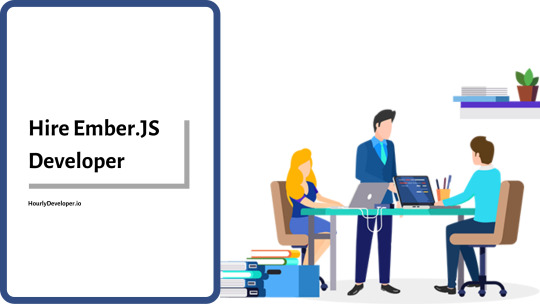
Looking to develop a scalable single-page web application? A HourlyDeveloper.io, EmberJS Development Company is open-source which is developed using JavaScript web application framework. Hire Ember.js Developer to create a web application in a very fast manner of automatic updating, less in code, and time. It is done in the speed of a jet. Our team of experts who work for more than a decade in handling projects with Ember. Consult with experts: https://bit.ly/3fNpVqr
#Hire Ember.js Developer#Ember.js Developer#Ember.js Development Company#Ember.js Development Services#Ember.js Development#Ember.js
0 notes
Link
4 notes
·
View notes
Link
Ember.js development services include everything that you require to develop rich UIs that work on any device. It is a rich, well-tested JavaScript framework for creating modern web applications. The major objective of Ember.js outsourcing services is to provide desktop like feel to the applications that are being built as well as to its source code.
1 note
·
View note
Link

Hire ember.js developer for 2020 from OnGraph. Our team of expert Ember.js developers and programmers, available on a part-time, full-time, or contract basis. so you can hire them for your most important and well-timed projects.
#EmberjsDevelopmentServices#EmberJSDevelopmentCompanies#Emberjsoutsourcingservices#Emberjsoutsourcingcompany
1 note
·
View note
Text
(Why) React is a Framework
!! As an immense disclaimer !!
I want to reiterate that this is basically subjective and belongs in the realm of bullshit metaphysics, which programmers are just great at.
Moreover, I don't really care a whole lot about the semantics and haven't been writing react code for about a year at this point. I think you can call it either a library, or a framework, or both!
Nevertheless, I wanted to provide my own perspective on this because I think it's a good launching point for
(Also yes I am this obnoxious with colours, I just love using colours ok)
So what's the problem here?
The first time I was really confronted with this must have been when I was toward the tail end of my coding bootcamp in the early months of 2020 and I decided to go along to a little Javascript conference during the early stages of my tech job hunt.
One of the speakers was giving a talk about the latest exciting things happening with React, which was still new to me at the time as I had mostly worked with Ruby, Rails and vanilla JS.
But in any case, I remember one part of the talk in particular. He quizzed us with a show of hands on whether React was a library or a framework, after which he joked (I hope) that he didn't hire people who thought React was a framework and not a library. Most likely in good fun, but this issue also pops up in the context of serious programming material.
This excerpt from What React is and Why it Matters, for instance, is very explicit in stating React is a Library, Not a Framework.
Moreover, we get a definition which I think captures a lot people's reasoning as to why they don't see React as a full framework:
One important distinction between libraries like React and frameworks like Ember.js and AngularJS is that React is concerned only with rendering the UI and leaves many things up to each project to put together.....React’s choice to be a library has allowed projects to adopt it more incrementally and has left the door open to rapid innovation from the community on various other parts of the stack.
There are other definitions out there, and the point which I'm trying to set up here is hardly special, but there are a couple disagreements I have with the above definition.
Firstly, 'only with' is doing quite a bit of heavy lifting in my view; that's pretty central to what a frontend application is at its core and frankly features such as persistent state and routing aren't really central features of a frontend application in the sense that, well, a UI is.
Secondly, while it is true that AngularJS is more opinionated and ships with CLI build/test tools and routing, it doesn't ship with 'everything' you might need; it lacks app-level state management, as a counter-example. In turn, SvelteJS ships with stores à la Redux, but if you want routing you'll either need another library or to use SvelteKit. As it turns out, a lot of frameworks we accept as such still leave many things up to us, the developers, so then where is the cutoff point that includes these other things but excludes react?
In fact, going back to my time with Rails, what about authentication? That's pretty important to a framework such as Rails, which covers both the frontend and the backend of your application. Now don't get me wrong, it *is* possible to cook up your own authentication solution in house using what Rails provides you, but many will use Devise as I did, or Cancancan, or Pundit.
In fact you might say fuck it and use OmniAuth or some shit so that facebook or google handle your user authentication for you. In fact, on the topic of security and coming back to frontend frameworks, React forms sanitise all text inputs by default. That's... above and beyond just 'rendering the UI' but is also really nice to have because sanitisation requires a ton of care and bespoke implementations are generally avoided (Because XSS can be very crafty).
Thirdly, you can adopt basically anything incrementally if you're brave, or crazy, enough! But for reasons which I'll come back to later, this... isn't really much more feasible for React than for others.
My point being, there are many important concerns a given framework isn't guaranteed to handle, but every framework provides handling for some key concern (in this case, the UI) and then some of the others.
But we're focusing on the wrong thing: after all, what *isn't* a framework by this definition? How do we know when a library... is just a library?
So, what makes something just a library?
>Crowd already booing by this point
I'm gonna just say it. Ahem. A package of code in use in a tech stack is a library, but not a framework, when it can be used without affecting the structure of your program.
The natural response to this is, What the fuck are you on about!? Libraries, after all, are there to share code so we don't have to reinvent the wheel 500 fucking times like we're C programmers in the 80s.
We are at the point where pulling a teensy tiny 11-line library from npm can sink all of web development for a bit. A useful library doesn't just leave an impression on a couple codebases: nay, it lives absolutely and indomitably goddamn fucking everywhere, like earth worms in a rich patch of soil.
But in fact, with most libraries there is another way! Recently I've been reading David Farley's 2021 book Modern Software Engineering which has given me some new ideas; I'm not really one to sprinkle design patterns everywhere for their own sake and I like to keep it simple (stupid!), but I must admit ports and adapters - aka hexagonal architecture - really helps with vital program dependencies in any paradigm.
In the example - for simplicity's sake and because needless to say libraries can get this small and still be relevant - we will consider the absolute heinous khrafstra of a thing that is javascript's standard Array.prototype.sort(). Seriously, look at this shit.

Now, naturally a common use case would be to put in something better! Let's say, for example, that we're in CompSci class territory and we've got a bubble sort that does the job and we have it in a bunch of silly little procedures like this - imagine not just allInOrder, but a whole file or two's worth of processes that can benefit from in-place sorting:

However, let's say we've been gnomed and decide we'd want to use gnome sort. In this case, we would have to put it everywhere we were formerly using bubbleSort...
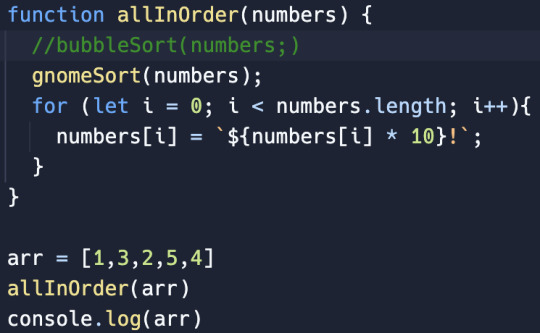
Now, in a case such as this we could just do a simple find and replace for bubbleSort with gnomeSort. But, especially with more complex dependencies and to avoid raking through swathes of the codebase in any case, we could instead wrap our sort of choice:
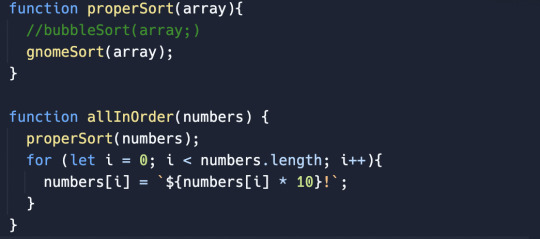
This way, we can gnomeSort, bubbleSort - I mean fuck it, we could put in bogoSort if we wanted! Or maybe, we could use something like an insertionSort or a quickSort or some other algorithm that's actually used in the real world... But we've encapsulated that choice. Thus, we only have to change the internals of one function, and as far as the rest of the code is concerned we're using a proper sort and not whatever Array.prototype.sort() is up to.
Again, just one lil function like this shouldn't usually need to be wrapped in this way, but you can imagine for an entire library the ability to do this really starts to matter!
(There's certainly some old sqlalchemy code I would handle differently today... this sort of thing also helps with dependencies in testing, you see)
If you wrap a major dependency in a module - such as a database client for a given databasing solution, or a set of interactions to a REST API you're using - we can switch said library/API out by reworking that module's internals such that it still satisfies its interface with the rest of the program.
In order words, your program remains loosely coupled with its dependencies.
While you certainly don't have to do this with libraries especially for smaller projects (paralysis by analysis, anyone?), the important part is that you can.
So, how does this all relate to React?
Why React isn't just a library
A framework, however, does fundamentally shape the structure of messages within your code rather than simply living in it, and will do so whether you like it or not.
(Well, most of the time - you can adopt anything incrementally if you're brave enough...).
To illustrate this a little better, let's take a look through Vite's React TS playground. First, we'll start at the index.html:
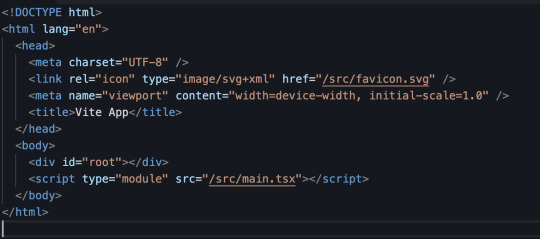
The source of our script is in main.tsx, so we'll take a look at that:
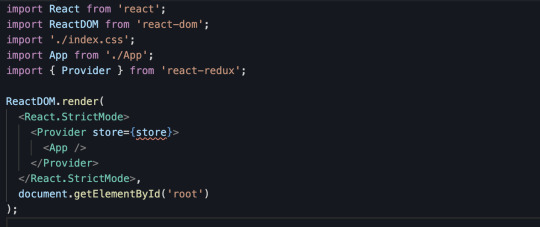
Needless to say, your frontend React project is initialised and runs in the first place via React itself. You take your <;App/> component, wrap it in a couple other things and then pass it all to ReactDOM.render() along with a reference to the root element.
At the very least, all React component code that you're planning on running is going to run under the auspices of APIs provided by React. You can't really encapsulate the fact you're using React from your higher level UI logic to any meaningful benefit, because React is the runtime for all UI code produced with it! I think this is part of the reason why you simply don't see 'incremental' adoption of React into codebases in the wild.
Focusing on React JSX/TSX specifically, a major complaint I've seen with it is that it's entirely non-portable: in virtually all cases you are not simply going to be able to switch from React to something else without having to rewrite the entire structure of the UI.
None of this is to say that this is bad - I've actually quite enjoyed writing JSX/TSX most times I've done it - but to me this isn't just a library. It determines the structure of your code, rather than simply being encapsulated within it.
So what have we learnt?
In my view, a library can be fully encapsulated by your code. A framework, instead, shapes your code. Furthermore, though the boundaries are a little fuzzy, I'd argue that React belongs very much in the latter camp.
#reactjs#react#javascript#framework#frontend#webdevelopment#coding#webdev#software#software engineering#full stack web development
1 note
·
View note
Text

Ember.js Performance Optimization
Discover essential Ember.js performance optimization strategies to scale your web application efficiently. Learn best practices, tips, and techniques to improve speed, reduce load times, and enhance user experience in Ember.js projects.
#Ember.js Performance Optimization#Ember.js Web Application#hire Ember.js developer#Software development#Ember.js scaling#Primathon
1 note
·
View note
Photo

Best Frontend Frameworks for 2023
Get ready for the future of frontend development with these top frameworks for 2023!
Angular
ReactJS
VueJS
Next.JS
JQuery
Svelte
Ember.JS
Solid.JS
Backbone.JS
Semantic UI
Bootstrap
Preact
Read a detailed article about this - https://infinijith.com/blog/framework/best-frontend-frameworks
If you need developer for your project, check out Infinijith to hire your developer!
#frontenddevelopment #webdevelopment #webdesign #programming #javascript #webdev #webtech #codinglife #technews #developercommunity #framework #frontendframeworks
0 notes
Text
8 Effective Tips To Help You Select The Best Angular App Development Company

The COVID-19 pandemic has a key role to play in the transformation of mobile communication. In addition, 5G is laying yet another brick in the foundation of a mobile-friendly global ecosystem. The strength of the global internet mobile population has reached 4.28 billion and developers are progressively responding to this technological shift. Web and mobile apps have found a stronghold in the market. Organizations are keen to develop engaging and interactive apps. This pursuit of developing apps to gain deeper penetration in the internet mobile population has compelled us to seek different app development frameworks. Angular JS is a very prominent name in application development. Let us try to understand what is Angular app development and what makes it important.
What is Angular JS?
Angular JS is a web and mobile app development structural framework. The use of HTML, JavaScript, and support for a wide range of frameworks including Backbone.js and Ember.js makes it a very popular choice. It offers many features including:
Code re-usability
Effective testing
MVVM and MVC architecture integration
Two-way data binding
DOM manipulation
Dependency injection
Data organization filters
Large community support
Ease of use
Without getting into details, let’s jump on to understand what makes Angular relevant and the reasons behind hiring an Angular.js development company for your next project.
Why Hire an Angular App Development Company?
Angular JS can be used to develop a variety of apps including e-commerce apps, games, tutorials, native desktop apps, and every other application type in demand. Some popular companies such as HBO, Forbes, and Nike are already using the Angular JS framework. In terms of apps, three types of apps can be built using Angular JS:
Progressive web apps (PWA)
Angular 5 comes with built-in PWA support. In addition, new CLI features have been introduced in Angular 6. Angular.js development services can leverage all these features and develop progressive apps for you.
Enterprise web apps
TypeScript and different features such as advanced refactoring and navigation can be put together to develop large-scale enterprise apps.
Dynamic web apps
Angular app development can be used to develop highly-responsive Single Page Applications using a variety of supported tools.
Hiring an Angular JS app development company will equip you with the potential to develop the most marketable application for your company. Angular JS brings structure and consistency to web application development. At the same time, it paves the route to maintainability and scalability that would be a necessity in the long run.
The clarity on the reasons to hire experts for Angular app development is just one step towards the goal. The next step of finding a great Angular App development company can be tedious. To make things easier, we have conducted thorough research to come up with 8 tips that can help you in the hiring process.
Tips to Hire an Angular App Development Company

1. Conduct and collate the research
Conducting thorough research on the best angular js development company is the first thing to accomplish. Companies can collect the names of app development companies through 3 main sources:
Recommendation
Recommendations from colleagues, competitors, and friends can save time otherwise invested in research about that particular company. Always connect with different people and make a list of the Angular app development companies.
Internet
Searching the internet for companies offering Angular app development services would accumulate a good list of names. Renowned business listing sites will be helpful in this case. These names can be further processed and shortlisted.
Posting vacancy
Fortunately, we live in a connected age where one post can give you a high level of penetration into the market, fetching you a response from small to established Angular.js Development Companies.
2. Short-listing the candidates
Collate the results from these three sources to produce one single list of angular.js application development companies. Start short-listing the companies. Visit the website of every company to check its authenticity and the services offered by them. Check the past collaborations to find out if they have a prior experience in the same domain. Also, have a look at the case studies to get an idea of the domain-specific use cases they have worked on.
3. Finalize requirements
Just a business idea may be an insufficient pitch for Angular.js developers. Conduct formal meetings with the business and marketing team to finalize different aspects of the application. You can conclude upon:
Features of the application
Target audience
Technologies to be used
Cost of development
Future scope of involvement with the Angular.js development services
Revenue model
Of all the mentioned aspects, fixing the cost of development can be taken up as a priority. The emergence of a variety of technology has changed the way we look at things. Customer behavior is changing rapidly and it is hard to anticipate customer behavior for the next five years. The company you choose for Angular.js mobile app development should have a futuristic approach. Your application should have white spaces for accommodating technical changes in the future. It would be advisable to make judicious use of the money and invest in a company that promises quality instead of going for cheaper services.
4. Schedule an interview
One-on-one meetings never go out of context. Schedule a meeting with all potential candidates. In the meantime, pre-plan the meeting and make a list of queries. Ask about:
Experience with similar projects
The technologies and tools used for the project
The team you would collaborate with
Costing and strategy for project extension
Skills and experience of the Angular app developers
Potential means of communication during the development cycle and emergency
This can serve as the restricted list of queries that can be extended with further business-related queries.
5. Check the technical skills of the developer
Any application aims to scale in the future, bringing new technologies and data into the picture. Set technology as an entry barrier for all the companies offering Angular.js application development. Enquire the proficiency of Angular app developers in JavaScipt, AngularJS, MVVM architecture, and Angular JS development tools such as WebStorm and Angular IDE. The Angular developer must be capable of choosing the best tech stack for application development.
Next in line is the update part. The angular app would require continuous updates based on consumer demands, involving a series of development activities such as tracking dependencies, optimizing images, and creating packages. Angular.js developers should be abreast with all these aspects. Connect with the Angular JS developer in person and assess their experience and knowledge in developing apps. A face-to-face interview with the developer itself can be an eye-opener, giving you a heads-up on whom are you going to deal with.
6. Find out the UX expertise
User experience (UX) plays a pivotal role in the success of any application. Let’s not get confused with front-end development and UX development. UX involves mapping customer behavior and developing the wireframes for front-end development. Many Angular app development companies house dedicated UX teams. Onboarding a UX expert to dedicatedly work on your project can help you refine every component of the application. You should raise a concern in case the Angular JS developer is also taking care of the UX. Insist on meeting the developer in person to assess their command of UX development. In case of incompetence, hire a third party for the user experience.
7. Performance assessment strategies
Regular performance assessment is imperative for any app to thrive in today’s competitive environment. Many performance assessment tools highlight the loopholes as well as the strong points of the application. Any company persistently works on the highlighted shortcomings to improve user response.
Who takes responsibility for the application performance? Hold discussions with the Angular app development partners to draw a clear line on the responsibilities. Also, the agreement of collaboration should contain clear terms of engagement concerning performance assessment and required technical changes. There should be clarity on the duration and cost of rework.
8. Take a Hard-line over the Discussion
Document every discussed point right from the days of engagement to rework cost. Any undocumented parameter would leave an open end in the discussion. At the same time, restrain from getting into long-term agreements with any new vendor. Restrict the engagement to project-based agreements. It would be wise to wait for the results of the 1st project before extending the agreement. Also, things that cannot be documented should be recorded in the mail as proof. Similarly, the MOM can be shared after every meeting to keep up with transparency. This communication should be maintained throughout the application development cycle.
Conclusion
Hiring Angular app development company is an extensive process that requires pre-planning. When executed in a planned manner with these tips into consideration, you can end up with the best third-party partnership. Angular JS developers can create customer-centric business solutions with limited time and resources. An Angular app development company will go through your requirements and allocate the best-suited angular app developers for your project, saving the hassles of finding the best resource in the crowded ecosystem of developers.
0 notes
Text
Hire Ember js Developers Hire Ember.js developers for efficient web app development. Experienced team to build powerful and scalable applications.
0 notes